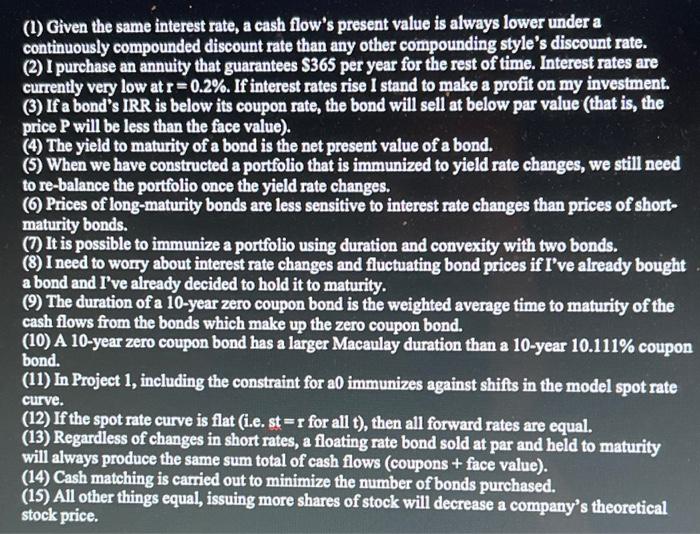Answered step by step
Verified Expert Solution
Question
1 Approved Answer
T/F questions (1) Given the same interest rate, a cash flow's present value is always lower under a continuously compounded discount rate than any other
T/F questions 
(1) Given the same interest rate, a cash flow's present value is always lower under a continuously compounded discount rate than any other compounding style's discount rate. (2) I purchase an annuity that guarantees $365 per year for the rest of time. Interest rates are currently very low at r=0.2%. If interest rates rise I stand to make a profit on my investment. (3) If a bond's IRR is below its coupon rate, the bond will sell at below par value (that is, the price P will be less than the face value). (4) The yield to maturity of a bond is the net present value of a bond. (5) When we have constructed a portfolio that is immunized to yield rate changes, we still need to re-balance the portfolio once the yield rate changes. ( Prices of long-maturity bonds are less sensitive to interest rate changes than prices of short- maturity bonds. (7) It is possible to immunize a portfolio using duration and convexity with two bonds. (8) I need to worry about interest rate changes and fluctuating bond prices if I've already bought a bond and I've already decided to hold it to maturity. (9) The duration of a 10-year zero coupon bond is the weighted average time to maturity of the cash flows from the bonds which make up the zero coupon bond. (10) A 10-year zero coupon bond has a larger Macaulay duration than a 10-year 10.111% coupon bond. (11) In Project 1, including the constraint for a0 immunizes against shifts in the model spot rate curve. (12) If the spot rate curve is flat (i.e. str for all t), then all forward rates are equal. (13) Regardless of changes in short rates, a floating rate bond sold at par and held to maturity will always produce the same sum total of cash flows (coupons + face value). (14) Cash matching is carried out to minimize the number of bonds purchased. (15) All other things equal, issuing more shares of stock will decrease a company's theoretical stock price. a 
Step by Step Solution
There are 3 Steps involved in it
Step: 1

Get Instant Access to Expert-Tailored Solutions
See step-by-step solutions with expert insights and AI powered tools for academic success
Step: 2

Step: 3

Ace Your Homework with AI
Get the answers you need in no time with our AI-driven, step-by-step assistance
Get Started


